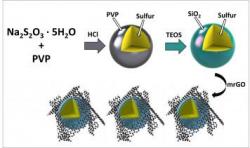| Online: | |
| Visits: | |
| Stories: |

| Story Views | |
| Now: | |
| Last Hour: | |
| Last 24 Hours: | |
| Total: | |
Glass cages and graphene oxide to improve lithium-sulfur batteries
Researchers from the Bourns College of Engineering at the University of California, Riverside investigated a strategy to improve lithium-sulfur batteries‘ performance by creating nano-sized sulfur particles, and coating them in glass.

Lithium-sulfur batteries have been attracting attention thanks to their ability to produce up to 10 times more energy than conventional batteries, but one of the main roadblocks to implementing them is a the tendency for lithium and sulfur reaction products (called lithium polysulfides) to dissolve in the battery’s electrolyte and travel to the opposite electrode permanently, which causes the battery’s capacity to decrease over its lifetime. The scientists designed a cathode material in which silica (glass) cages “trap” polysulfides.. The team used an organic precursor to construct the trapping barrier.
Source: http://www.graphene-info.com/glass-cages-and-graphene-oxide-improve-lithium-sulfur-batteries



